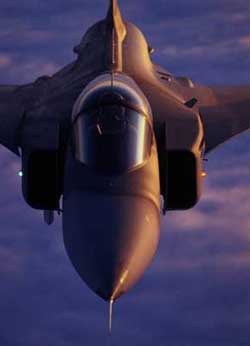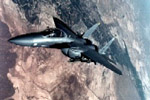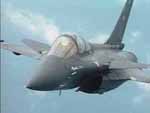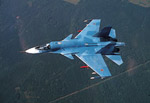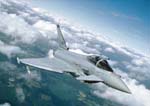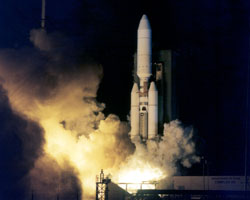Page 1
Daily News
By Gail Helmer
| Send Us News | Archives | Main |
Thursday January 17, 2002
PC News
- Lock On: Modern Air Combat Official Site
- OpFlash Patch 1.42 Due Friday
- MOHAA System Specs Released
- Warbirds Extreme Coming Soon
- EA to Debut New Packaging for PC Games
- Gates Calls for New Focus on Security
- Northrop Grumman To Upgrade Army's Firefinder Radar
- Third Swedish Gripen Wing Inaugurated
- ATK Gets Repeat Order For Sparrow Missile
- South Korea Says F-X Fighter Bids All Too Expensive
- Army Declares "Black Hawk Down" 'Authentic'
- Air Force Satellite Launch A Success
Lock On: Modern Air Combat Official Site
The official Lock On: Modern Air Combat web site is now live. In addition to providing overview information about Lock On, the site will be provide weekly screen shots, producer's notes, interviews, and more.
Lock On: Modern Air Combat combines a broad scope of game play that includes a dynamic battle generator, an immersive combat environment, and in-your-face action. Choose from eight U.S. and Russian jets that range from the tank-killing A-10 Warthog and, ground-pounding Su-25 Frogfoot to air superiority fighters like the F-15C Eagle and Su-27 Flanker. Filled with intense campaigns, realistic flight modeling and flexible game options, Lock On will provide unlimited game play action to both novice and veteran flight sim fans.
OpFlash Patch 1.42 Released
Operation Flashpoint Ultimate Upgrade 4, version 1.42 is now available. It remains compatible with 1.40 in multiplayer and it contains couple of fixes and some new additions, including:
Click here to download the Ultimate Upgrade 4, 1.42.
- Added: parameter "voiceOverNet" added to dedicated server config (default = true)
- Fixed: AI used binocular too often.
- Fixed: Repeated ".. is down" message when player was killed.
- Fixed: AI units cannot get in ships since 1.40
- Added: browsing in chat history using Page Up and Page Down in chat line
- Fixed: Cessna AI pilot swinging up and down when flying slow.
- Fixed: Helicopter took off after landing even when no waypoint was active (bug since 1.40).
- Fixed: Buffer overflow in XML parsing causing crashes to desktop with some XML squad pages
MOHAA System Specs Released
The official Medal of Honor site has released the System specs for the game.
The Official MOHAA System Requirements
Supported Chipsets:
- Windows XP/ME/2000/98/95 (Windows NT not supported)
- 450 MHz Intel Pentium or 500 MHz AMD Athlon processor
- 128 MB RAM
- 8x CD/DVD-ROM drive
- 1.2 GB free hard disk space plus space for saved games, Windows swapfile, and DirectX 8.0
- 16 MB DirectX 8.0 compatible video card with OpenGL support
- DirectX 8.0 compatible sound card
- Keyboard
- Mouse
Recommended
- ATI Radeon
- ATI Rage 128
- ATI Rage 128 Pro
- NVIDIA GeForce2
- NVIDIA GeForce 256
- NVIDIA GeForce3
- NVIDIA Riva TNT
- NVIDIA Riva TNT2
- PowerVR3 Kyro
- PowerVR3 Kyro II
Warbirds Extreme Coming Soon
- 700 MHz or faster Pentium III or AMD Athlon processor
- 32 MB DirectX 8.0 compatible video card with OpenGL support
Required for Multiplayer- 1 disc/player per computer
- Internet (2-32 players): 56 Kbps or faster Internet connection
- Network (2-64 players): TCP/IP compliant network
Abacus Software will soon release Warbirds Extreme, its upcoming modern air superiority add-on for Microsoft's Flight Simulator 2002 and Combat Flight Simulator 2. The add-on features detailed visual and flight models of 11 modern military aircraft, including the one-seat F-15C Eagle, the two-seat F-15E Eagle, three versions of the one-seat F-16C Falcon, four versions of the two-seat F-16D Falcon, the A-10 Thunderbolt II, and the B-2 Spirit stealth bomber. Screens
EA to Debut New Packaging for PC Games
Electronic Arts will roll out its PC games in new standard-sized boxes next week with the debut of the 3D shooter, Medal of Honor Allied Assault. The new packaging requires less space on retail shelves, which allows for more inventory. EA also says itís environmentally friendly.
Recently, the Interactive Developers Software Association recommended a smaller, standardized PC box for educational and entertainment software. Following the lead of the Interactive Entertainment Merchant Association, the IDSA recommends the standardized size of 5.25 inches wide, 7.5 inches high, and one inch deep, a package design with an established history in electronic media, including console video game and DVD packaging.
Gates Calls for New Focus on Security
Microsoft Corp. Chairman Bill Gates on Wednesday called for a fundamental shift within the software giant to focus on what many consider the company's Achilles' heel -- security against hackers and viruses. In a memo sent to Microsoft's 47,000 employees and made available to media on Wednesday, Gates said locking down the company's products -- a strategy he dubbed "Trustworthy Computing" -- was vital to the success of its .NET strategy to roll out Web-based services. [More...]
Military News
Northrop Grumman To Upgrade Army's Firefinder Radar
Northrop Grumman Corporation's Electronic Systems sector has been awarded a four-year contract by the U.S. Army's Communications and Electronics Command, Fort Monmouth, N.J., for follow-on production of its AN/TPQ-36(V)8 Firefinder radar system upgrade.
The contract calls for an additional 39 Firefinder radar set kits and spares valued at approximately $70 million, provided all options are exercised. The kit consists primarily of a new operator shelter and radar processor that will be used with an existing antenna. To date, 54 AN/TPQ-36(V)8 systems have been fielded by active Army, Army Reserve, National Guard and U.S. Marine Corps units.
Firefinder is used by field artillery units to provide enemy mortar, artillery and rocket-launch locations; target acquisition; and counterfire support for divisions, brigades and rapid deployment task forces.
"The AN/TPQ-36(V)8 represents the latest all-digital, highly mobile counter-battery radar fielded by the U.S.," said Dr. Robert Weber, Firefinder program manager for Northrop Grumman. "This variant improves significantly upon previous versions in system performance, crew survivability, life-cycle cost and maintainability." Dr. Weber credited the Firefinder integrated product team at Rolling Meadows with consistently meeting program production requirements.
The Firefinder system locates targets by using X-band radar to detect incoming mortar and artillery rounds and rockets. It then determines the launchers' positions and relays targeting data to a fire direction center (FDC) for counter-battery engagement.
Firefinder can also be used to correct the fall of friendly artillery fire by detecting rounds in flight and extrapolating impact points. This information is then passed back to the FDC to enable more precise target engagement with subsequent rounds.
Third Swedish Gripen Wing Inaugurated
Gripen operations have started at the third wing to receive JAS 39 Gripen aircraft, F21 at Lulea in the north of Sweden. Two Gripen aircraft with F21 pilots landed at their new home and were welcomed by some 600 guests.
F21 will be operating two Gripen squadrons, the first including 20 aircraft ready to operate from 2002 and a second squadron with another 20 aircraft from 2005. F21 already has five Gripen-aircraft at Kallax airbase and will complete its first missions this week.
"I am very glad that we can start to operate Gripen at Kallax Air base after more then a year of preparations, including education of technical support, pilot training and infrastructure", says Frank Fredriksson, Wing Commander at F21.
Gripen was officially introduced into Swedish Air Force service on 9 June 1996, where F7 Satenas was the first Wing to operate Gripen with two squadrons. On 30 September 1999 the second Gripen Wing was introduced at F10 Angelholm with further two squadrons. The first Gripen division at F21 will replace the AJSH 37 Viggen (reconnaissance) division and take part in peace support operations from 2004.
204 Gripen aircraft have been ordered for the Swedish Air Force, with deliveries due for completion in 2007. Of these, 28 will be the fully operational and combat-capable two-seat version. By the end of 2001 Saab had delivered 113 Gripen aircraft to the Swedish Defence Materiel Administration (FMV) - the government agency responsible for the procurement of the Swedish Gripen.
The first countries to order Gripen, after Sweden, was the South African Air Force which has a requirement for 28 aircraft and the Hungarian Air Force which has signed a lease contract with the Swedish Government for leasing of 14 Gripen fighters. Gripen International, which is owned by Saab AB of Sweden (50%) and the United Kingdom's BAE SYSTEMS (50%), has also started negotiations with Czech Republic for the delivery of 24 new aircraft. Other countries that are interested in Gripen are Austria, Brazil and Poland.
ATK Gets Repeat Order For Sparrow Missile
ATK (Alliant Techsystems) has received an additional $9 million contract from the Naval Air Systems Command, for Sparrow missile rocket motors, bringing the total value of production options awarded in 2001 to $25 million. The company received a contract option valued at $16 million in November.
Work under the current contracts will continue through December 2003. The motors are being procured under the Foreign Military Sales (FMS) programme and will satisfy individual country requirements.
The Sparrow is a medium-range, radar-guided, aerial-intercept missile with a high-explosive warhead that flies at supersonic speeds. It can attack high-performance aircraft and missiles from any direction. The motors contain separate boost and sustain propellants in a side-by-side configuration to propel the missile to its target.
South Korea Says F-X Fighter Bids All Too Expensive
South Korea has called a halt to the bidding for its F-X fighter procurement, saying that all the bids from the four competitors were too high. The South Korean Defence Ministry has given the four companies until 24 January to revise their bids.
The competing aircraft for the $3.25 billion, 40 aircraft F-X project are Boeing's F-15, Dassault's Rafale, the Eurofighter Typhoon and Sukhoi's Su-32. The F-15 and the Rafale are considered the front runners for the contract.
In a contract process that has already been delayed several times, the South Korean MOD wants to complete price negotiations first before considering other factors. If no contender has a clear price advantage of more than three percent over the others, then, according to the MOD, factors such as 'compatability' would come into play.
The 'compatibility' issue, announced last month, has raised concerns that the MOD has succumbed to heavy and unsubtle lobbying by Boeing and the US Government and favours the ageing F-15. The US Government recently said that it could not guarantee the supply of US air-to-air missiles for integration onto a 'foreign' aircraft.
Army Declares "Black Hawk Down" 'Authentic'
When Jerry Bruckheimer met with Gen. John M. Keane at the Pentagon, the Hollywood film producer told the Army vice chief of staff he planned to make a movie about the Army's 1993 battle in Mogadishu, Somalia.
At the Jan. 15 premiere here of "Black Hawk Down," Keane recalled: "He came into my office and said, 'General, I'm going to make a movie that you and your Army will be proud of.' He did that, so we thank him for it."
Bruckheimer's film, slated for national release Jan. 18, is based on Philadelphia Inquirer reporter Mark Bowden's book, "Black Hawk Down: A Story of Modern War." Both tell what happened when Army Rangers and Special Forces soldiers conducted a raid in Mogadishu on Oct. 3, 1993. The 18-hour battle against Somali militia loyal to warlord Mohamed Farrah Aidid killed 19 American soldiers and more than 1,000 Somalis.
Keane, whose military career includes command of the XVIII Airborne Corps, the Army's largest warfighting organization, said "Black Hawk Down" is an "authentic" and "graphic" portrayal of war.
"I don't think it's a movie you necessarily enjoy," he noted. "It's a movie -- particularly for those who have fought in a war -- that you experience."
The film accurately captures what it's like for soldiers in "the crucible," the general said. Whether in Somalia or Afghanistan, he explained, that's where soldiers on the ground "need one another to survive and to defeat an enemy." It's where "you have to call on your inner strength and overcome your natural fears."
Keane, Army Chief of Staff Gen. Eric Shinseki and Marine Corps Gen. Peter Pace, vice chairman of the Joint Chiefs of Staff, were among the top brass at the debut. Vice President Dick Cheney, Defense Secretary Donald H. Rumsfeld and Deputy Defense Secretary Paul Wolfowitz and other civilian defense leaders also viewed the screening.
Army Secretary Thomas White gave the film a "thumbs up" and praised its "tag line," "Leave no man behind." This pledge, he noted, is appropriate both for the movie and the soldiers who serve today across the world and particularly in Afghanistan.
"It's been appropriate for the entire 226 years of the United States Army's history," White said. "We have certainly seen that spirit of heroism many times in the past few months."
The movie is based on actual events, but some liberties had to be taken, such as compositing characters. Nevertheless, White told the audience, "the values portrayed here are absolutely authentic. They represent the core Army ethic of courage and selfless service.
"I'm proud to say that same courage and selfless service can be seen today in Afghanistan and wherever American soldiers serve around the world in some 100 different countries."
Along with Bruckheimer, the Hollywood contingent included director Ridley Scott and actor Josh Hartnett, who plays Army Staff Sgt. Matt Eversmann.
Bruckheimer, whose credits also include "Pearl Harbor" and "Top Gun," said he chose to make "Black Hawk Down" to "set the record straight" and to change an impression created by the press.
"This was a very heroic mission for these young men," he said. "They don't set policy, they enforce it. They went in there and did an amazing job.
"I read Mark's book before it was published back in 1997 and thought it was an extraordinary tale of courage and bravery and heroism about these young men who fought so valiantly," he said. "The press labeled it a debacle. We wanted to set the record straight."
The producer introduced Eversmann, now a sergeant first class, and several other soldiers in the audience who participated in the Mogadishu raid. Eversmann, whose platoon was the first to reach the first of two downed Black Hawks, said he believed the producer had accomplished his mission.
"It's not a biography and it's not a documentary," he said. "It depicts the actions of soldiers very authentically, probably as realistically as we could expect without a real combat photographer on the ground during the battle."
But it's also a product of Hollywood," Eversmann noted. "There are some things that were done for the sake of filmmaking, and I understand that. So barring some of those little idiosyncracies, you look at the scenery, that's very authentic. You look at the way soldiers behaved, how they're outfitted, that's very authentic. The actions they take are very authentic. You put it all together -- I tell you, they did an unbelievable job."
Chief Warrant Officer Rodney 'Sam' Shamp of the Army's 160th Special Operations Aviation Regiment, piloted Black Hawk 'Supersix Seven' during the raid. He also lauded the film.
"From a human standpoint, it was absolutely fantastic," he said. "I believe they did an excellent job of capturing the emotions, the feelings and the camaraderie that comes from combat and the professionalism that existed.
"From a military standpoint," he added, "you never want to show absolutely everything the military does and how they do it, but the portrayal of what we did was quite excellent from a tactical standpoint."
Army Sgt. 1st Class Jeff McLaughlin, another soldier who was in Mogadishu that day, agreed that Bruckheimer told it like it was. McLaughlin, a member of the 75th Ranger Regiment at Fort Benning, Ga., verified the film's accuracy and said he's glad the film was made.
"It was pretty realistic," said the noncommissioned officer, who's just returned from Afghanistan. "There was a timing sequence that wasn't exactly right, but other than that and a few small, what I call 'Hollywoodisms,' it was really accurate. They did a good job.
"A lot of courageous things went on that day," McLaughlin concluded. "It's good that the public gets to see what some of those things were."
Air Force Satellite Launch A Success
The Air Force successfully launched a Titan IV-B rocket carrying a MILSTAR II communications satellite from Space Launch Complex 40 here Jan. 15 at 7:30 p.m. EST.
Successful separation and orbital insertion of the satellite occurred early Jan. 16, about six-and-a-half hours after liftoff.
"The satellite is on target and its solar arrays deployed as planned," said Capt. Patrick Youngson, chief of the MILSATCOM operations section at Air Force Space Command headquarters. "We have a fully functional satellite in the proper orbit."
MILSTAR II is the Department of Defense's most technologically advanced telecommunications satellite.
"The importance of this particular satellite is that it will complete worldwide coverage for our (MILSTAR) constellation," said Christine Anderson, director of the military satellite communications joint program office at the Space and Missile Systems Center.
MILSTAR is a joint-service satellite communications system that will provide secure, jam-resistant worldwide communications to meet the essential wartime requirements for high-priority military users. The multisatellite constellation will link command authorities with a wide variety of resources, including ships, submarines, aircraft and ground stations.
The Air Force had significant firepower in place for the launch to counter any possible terrorist threat. F-15 Eagles from the 125th Fighter Wing at Jacksonville, Fla., flew combat air patrol missions over the base here on days leading up to the launch, as well as on launch day. There were also several ground assets deployed in the area.
"As we demonstrated for the shuttle launch in December and again for this launch, the Air Force will take all reasonable measures to protect America's national space assets and missions," said Maj. Mike Rein, 45th Space Wing. "And we plan on doing it for all future launches as well."
The Titan IV-B rocket completed its portion of the mission about nine minutes after liftoff, then it separated from the MILSTAR II satellite and the Centaur upper stage that boosted the satellite into its orbit. The MILSTAR II satellite should become operational in approximately 120 days.
"It was a beautiful flight," said Lt. Col. Dave Jones, Air Force Launch Director. "All the members of our Titan team can be justifiably proud that we launched a satellite that will extend America's global reach, global power and global vigilance. It will make a difference for us in the war on terrorism and future conflicts."
| Send Us News | Archives | Main |

